![]()
![]()
![]()
Use LEFT and RIGHT arrow keys to navigate between flashcards;
Use UP and DOWN arrow keys to flip the card;
H to show hint;
A reads text to speech;
15 Cards in this Set
- Front
- Back
|
exceptions to Mendelian segregation rules
|
1. intra-allelic interaction 2. multiple alleles 3. inter-allelic interactions |
|
|
intra-allelic gene interactions
|
1. complete: one allele dominates 2. incomplete: one allele partially dominates 3. co-dominance 4. over-dominance -talking about one gene and the interactions between alleles of that gene |
|
|
______ is only individual intra-allelic interactions can be observed in
|
heterozygous
|
|
|
incomplete dominance
|
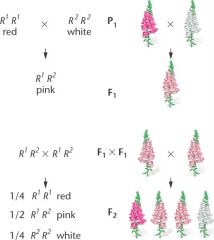
-when the heterozygous genotype exhibits an intermediate phenotype between the two homozygous genotypes -you can tell the difference between heterozogous and homozygous dominant -F2 1:2:1 genotypic and phenotypic ratio instead of 3:1 (same as codominance) -e.g. R gene encodes an enzyme involved in pigment synthesis -R² produces no pigment (white) -R¹R¹ produces enough pigment o make the flower red -R¹R² produces 1/2 the pigment (pink) and is intermediate |
|
|
codominance
|
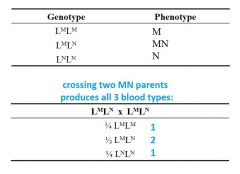
-F2 1:2:1 genotypic and phenotypic ratio (same as incomplete dominance) |
|
|
multiple alleles
|
-greater than 2 alleles exist for a gene (or a locus) → ↑ # of possible genotypes (but a diploid will still only have 2 alleles) -multiple types of allelic series/relationships: 1. incomplete dominance or codominance: # of possible phenotypes = # of possible genotypes (e.g. ABO blood groups) 2. simple dominance hierarchy (Mendelian): each allele is dominant to the remaining alleles in a series, arrange alleles in order of dominance, # of phenotypes = # of alleles (e.g. rabbit coat colour) |
|
|
ABO blood groups |
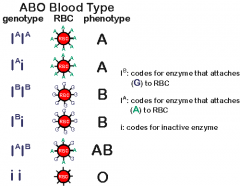
-three alleles: IB, IA, IO (i) -characterized by presence/absence of A an B antigens on RBC surface -alleles IA and IB are codominant to each other and dominant to IO |
|
|
coat colour in rabbits
|

-simple dominance hierarchy -C > cch > ch > c -C: wild-type (brown) -cch: chinchilla (light brown) -ch: Himalayan (white with brown extremities) -c: albino (white) |
|
|
inter-allelic interactions
|
-talking about multiple genes interacting -epistasis: expression of one gene/gene pair masks/modifies expression of another gene/gene pair -because: genes specify proteins, enzymes are proteins, multiple enzymes can be involved in a single phenotype -modified Mendelian F2 ratio (9:3:3:1 changes) |
|
|
ratios resulting from epistasis |
PICTURE AND VOICE RECORDING -crosses between heterozygotes → all modifications of 9:3:3:1 ratio -all looking at 2 genes even though producing one trait |
|
|
recessive epistasis
|
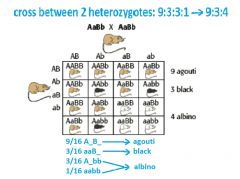
-heterozygote cross: 9:3:3:1 → 9:3:4 -e.g. coat colour in mice -gene A: distribution of pigment in hair: allele A (wild type/agouti/banded), allele a (black colour) -gene B: production of pigment in hair: allele B (allows pigmentation to occur), allele b (albino) -when the mutated b is homozygous, doesn't allow pigmentation to occur → effects of gene A are masked |
|
|
dominant epistasis |
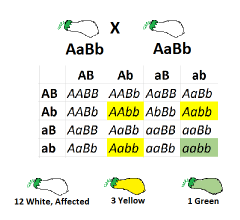
-heterozygote cross: 9:3:3:1 → 12:3:1 -e.g. genes A & B determine squash colour -dominant allele A (AA or Aa) → white fruit colour regardless of B/b allele present -absence of dominant allele A (aa) with a dominant B allele (BB or Bb) → yellow fruit colour -aabb → green fruit colour |
|
|
duplicate recessive epistasis
|

-e.g. flower colour -first demonstrated when cross f two white flowers → all F1 purple flowers → F2 modified ratio -flower colour controlled by genes A & B -presence of a dominant allele of each gene is required for purple flower colour -all other allele combinations → white (homozygous condition of either recessive allele masks expression of the dominant allele at the other locus) |
|
|
duplicate dominant epistasis
|
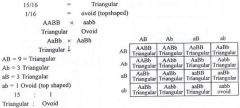
-occurs when 2 genes provide an alternative genetic determination of a specific genotype -heterozygote cross: 9:3:3:1 → 15:1 -e.g. genes A and B control fruit shape -presence of a dominant allele of either gene → triangular seed shape -when both genes are homozygous recessive → ovoid shape |
|
|
what all epistasis has in common:
|
2. F2 phenotypic ratio are expressed in 16ths (suggests that two gene pairs are controlling the observed phenotypes) * -when see 16 in ratios, that's your clue that it's 2 genes -when see 16 in ratio and it's not 9:3:3:1, that's your clue that its epistasis |

